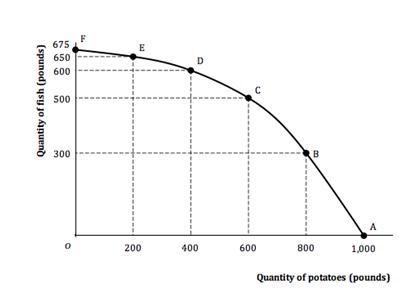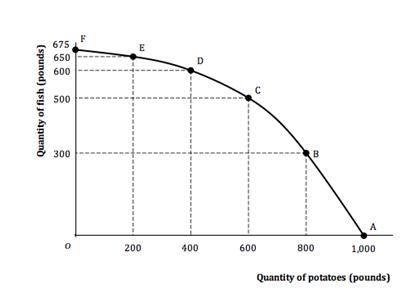Chapter 2. Question 2
2.1 Graphing
Atlantis is a small, isolated island in the South Atlantic. The inhabitants grow potatoes and catch fish. The accompanying table shows the maximum annual out-put combinations of potatoes and fish that can be produced. Obviously, given their limited resources and available technology, as they use more of their resources for potato production, there are fewer resources available for catching fish.
| Maximum annual Output options | Quantity of potatoes (pounds) | Quantity of fish (pounds) |
|---|---|---|
| A | 1,000 | 0 |
| B | 800 | 300 |
| C | 600 | 500 |
| D | 400 | 600 |
| E | 200 | 650 |
| F | 0 | 675 |
1.
Using the data in the table above which of the following graphs depicts the production possibility frontier with potatoes on the horizontal axis and fish on the vertical axis.
2.2 Multiple Choice

| Maximum annual Output options | Quantity of potatoes (pounds) | Quantity of fish (pounds) |
|---|---|---|
| A | 1,000 | 0 |
| B | 800 | 300 |
| C | 600 | 500 |
| D | 400 | 600 |
| E | 200 | 650 |
| F | 0 | 675 |
2.
Can Atlantis produce 500 pounds of fish and 800 pounds of potatoes? Explain. Where would this point lie relative to the production possibility frontier?

2.3 Fill-in-the-blanks
Assume the economy of Atlantis only produces fish (point F).

Calculate the opportunity cost of producing potatoes in 200 pound increments.
3.
| Maximum annual Output options | Quantity of potatoes (pounds) | Opportunity cost of potatoes in terms of fish |
|---|---|---|
| F | 0 | - |
| E | 200 | |
| D | 400 | |
| C | 600 | |
| B | 800 | |
| A | 1,000 |
2.4 Essay
| Maximum annual Output options | Quantity of potatoes (pounds) | Opportunity cost of potatoes in terms of fish |
|---|---|---|
| F | 0 | - |
| E | 200 | 25 |
| D | 400 | 50 |
| C | 600 | 100 |
| B | 800 | 200 |
| A | 1,000 | 300 |
4.
Can you explain why the opportunity cost of producing 200 pounds for potatoes is not the same as producing 800 pounds of potatoes? What does this imply about the slope of the production possibility frontier?